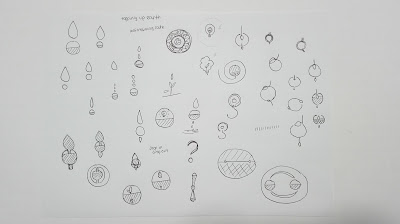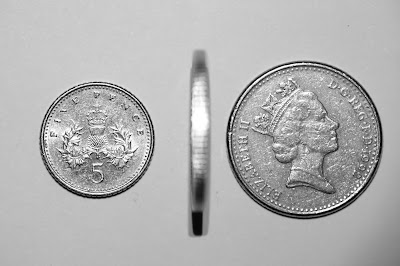Digital and Photographic Experimentation
Development of Initial Ideas
Coin Idea
Scanned Imagery
It was considered that the coin composition could be made digitally on Photoshop using the scanned images of the different coins. This would allow the elements to be freely positioned and edited. The coins were scanned into the computer however at full scale the coins couldn't be seen very well. Refining the scan area allowed the scan to be focused on the areas of coins making the image larger.
However it was found both as a composition and individually the image quality of the scans was not very good despite being 300 dpi, probably due to the small size of the coins. To move the idea forward photography and digital versions of the coins would be much clearer.
The scanned images however were good reference material for creating digital versions of the coins and allowed me to capture the light and dark shades within the coins to makes them look three dimensional rather than being purely illustrative.
Digital Experimentation
The £2 coin would act as a representation of Sephy and Callum as this combined two shapes into one allowing the different parts to be coloured seperately. Removing the markings from the coins gets rid of the monetry value and allows them to just be coins that are identifiable through colour.
It was considered that the coins for the crosses could either be black or brown, as brown would perhaps better reflect natural skin tone and also would avoid using the colour scheme seen in existing Noughts and Crosses Covers. The coins for the noughts were explored in both pure white and grey, as the grey elevated the design off the white background, whilst the white provided more contrast. Both tomes were used within the £2 outline to reflect Sephy and Callum within one coin.
Sephy and Callum would make up the £2 coin, whilst the black / brown coins are larger than the white / grey ones reflecting how the crosses are seen as more important within the book.
Enlarging the composition so the coins extend off the page creates a macro view of the coins. This means there is less negative space for the background and allows the focus of the design to be on the coins.
It was considered that the coins could have numbers on them to play with the idea that the crosses were worth more, however there was uncertainty as to wether this added anything to the design that hadn't already been visualised e.g the crosses coins were already larger.
Photographic Experiments
Full photoshoot of coin images
Using photography to capture the coins I thought might make them more identifiable as coins and therefore more related to the initial quote. Using black and white photography would link the design back to the concept of race however in a subtler way when compared with existing book covers.
Using a similar zoomed in composition to the digital designs, the photographic version had good contrast and definition. Shooting in monochrome also meant that the tones of the different coins were simplified to only two creating similarities between coins without the need for colour. However within this design it is not very clear what all the different coins are because of the zoomed in composition, which makes it hard to work out that there are two groups of coins.
This composition is zoomed out slightly to show the two groups of coins. The contrast in these images has worked well as the two groups of coins are clearly different reflecting race within the book.
Using the same set up as the last photograph and turning only the £2 over reflects the quote and shows the two sides of the coin.
Simplifying the concept back to only one coin like within the quote creates a bold design. Having one side of each of the coins on each side of the book cover creates the impression of physically flipping over a coin.
Having the coin on its side so that it aligns with the spine of the cover means that when the book lays flat it will also look like the coin is laying flat. This creates enhances the sense that the coin is being flipped over.
Within the quote it was said that they are two sides of the same coin, however within the book it is clear that this isn't the case. To reflect this it was considered that when the book is flipped over the the other side could be of a different coin with a different worth.
To emphasise the light and dark and differences between the two sides it was thought that adding a direct light over one side would reflect the noughts. However when a harsh light was used this meant the other half of the image was not as visible.
Adding a less severe light to the other side meant that Sephy's cross side was still visible.
Having a dark background around the light sources allowed separation to be created between the two sides emphasising their differences.
Bubble Idea
With the bubble idea it was considered the bubbles could be coloured differently to reflect whether they were noughts or crosses. An x shape would line up over a noughts bubble to suggests it is about to be shot down.
Having outline for the bubbles creates more of a light and airy feel to the design and suggests the transparency of their consistency.
Placing noughts or crosses within the bubbles could better suggest the difference between the two however this could also make the design look more obvious.
Using a dashed line for a popped bubble creates the impression the form is breaking up.
Making it so the daggers just touch the bubble suggests how sharp and easy it is for the bubbles to pop. Placing the dagger vertically above or below the bubble creates draws your eye through the design from the bubble to the dagger and vice versa, however is not reflective of the motion created when popping a bubble.
Once the dagger pops the bubble it continues through into the space it was once in.
Tilting the dagger slightly suggests more of a popping action however the colour of the dagger distracts the eye from the rest of the design.
Using a blue gradient for the background creates a sense of sky and airiness. Using a dashed line for the popped bubble and moving some of the elements makes the bubble look like its falling to pieces. However rather than falling down they should go out first.
(internet sky image)
Continuing with the background idea from the image before, it was considered that an actual sky (internet sky image) would create the effect of bubble floating up into the air. Lowering the opacity of the shapes an text allowed the design to look more airy and light. It was considered that the words within the title could be placed within the bubbles to make it look like they are floating upwards, whilst the design allows the both noughts and crosses to be considered equal.
(internet sky image)
Despite lowering the opacity on the filled circles to make them look more like bubbles the shapes still looked too blocky.
Adding different radial gradients to circles, then layering them up created more of a three dimensional bubble which was more realistic.
(internet sky image)
Placing the bubbles over the stock image worked well in emphasising elements within the design. The gradients within the bubbles interacted with the sky image in an interesting way and created depth within the design.
Oil and Water don't mix
Complete Oil in Water Photoshoot
The idea of noughts and crosses not mixing had previously been explored by joining crosses together and leaving the noughts floating within them but not able to join. Instead it was considered that oil and water don't mix in a literal way, which could act as a metaphor for how noughts and crosses are within society. To create the images, oil was placed in a dish that was elevated by placing the the edges of the dish on two stacks of CD's. Black card was placed underneath the dish to create a black background. White acrylic paint was was thinned with water. Drops of this mixture were put into the oil so that droplets were suspended within the oil. Using a macro lens allowed close up images of the water in the oil to be captured. The colour scheme within the image reflects the noughts and crosses. The rounded forms of the oil reflect the noughts through their shape and colour.

Having rounded forms better reflects the shape of the noughts. This was best created when the water was in beads and hadn't been moved. Using a torch to light the dish meant that a pitch black background could be created whilst highlighting the water drops creating strong contrast between the background and droplets.
Adjusting the lighting so that it was slightly higher meant that a shadow was created on the water droplets creating the effect of a gradient and making the droplets look more three dimensional.
Leaving the water in the oil for too long meant that the droplets started to sink into the oil rather than float on the top. Droplets would also collect together creating larger shapes.
Shaking the dish meant that the water separated into further droplets creating a more intricate and complex design.
Having more droplets made it more obvious that the design was created by mixing oil and water. This it was considered would best reflect the quote.




















































































